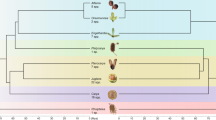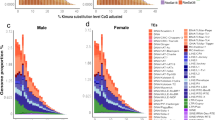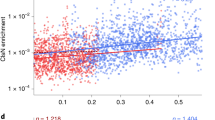Abstract
RECENT surveys show that variation in the amount of nuclear DNA, quite independently of change in chromosome number, is frequently associated with the divergence and evolution of both plant and animal species1–10. The extent of such variation is often very great, particularly among the angiosperms. One of the many problems posed by these findings is the nature of the chromosome structural changes which give rise to the DNA variation. Two proposals have been put forward. The first is a differential polynemy, that is, a difference in the lateral multiplicity of DNA strands between chromosomes of different species4,9. While this proposal has many theoretical attractions there is, to date, no direct evidence in its favour. Indeed, Callan11 has adduced evidence which argues strongly against this view. The second possibility is that the nuclear DNA variation is caused by lengthwise incorporation or loss of chromosome segments such as result from duplication or deletion. Observations in Lolium1 and in Chironomus3 hybrids at pachytene of meiosis and in polytene nuclei, respectively, show that the chromosomes of species with different nuclear DNA contents differ in respect of segmental duplications. There are therefore good grounds for attributing at least part of the DNA variation to such duplications. The following work in Allium provides further evidence to support this view. What is more, it shows that segmental duplications can account entirely for the DNA changes observed.
This is a preview of subscription content, access via your institution
Access options
Subscribe to this journal
Receive 51 print issues and online access
$199.00 per year
only $3.90 per issue
Buy this article
- Purchase on Springer Link
- Instant access to full article PDF
Prices may be subject to local taxes which are calculated during checkout
Similar content being viewed by others
References
John, B., and Hewitt, G. M., Chromosoma, 20, 155 (1966).
Keyl, H. G., Naturwissenschaften, 51, 46 (1964).
Keyl, H. G., Chromosoma, 17, 139 (1965).
Martin, P. G., and Shanks, R., Nature, 211, 650 (1966).
Martin, P. G., Exp. Cell Res., 44, 84 (1966).
Bees, H., Cameron, F., Hazarika, M. H., and Jones, G. H., Nature, 211, 828 (1966).
Kees, H., and Jones, G. H., Heredity, 22, 1 (1966).
Rees, H., and Hazarika, M. H., in Chromosomes Today, 11 (in the press).
Rothfels, K., Sexsmith, E., Heimburger, M., and Krause, M. O., Chromosoma, 20, 54 (1966).
Sunderland, H., and McLeish, J., Exp. Cell Res., 24, 541 (1961).
Callan, H. G., J. Cell Sci., 2, 1 (1967).
Author information
Authors and Affiliations
Rights and permissions
About this article
Cite this article
REES, H., JONES, R. Structural Basis of Quantitative Variation in Nuclear DNA. Nature 216, 825–826 (1967). https://doi.org/10.1038/216825b0
Received:
Issue Date:
DOI: https://doi.org/10.1038/216825b0
This article is cited by
-
DNA evolution in the genus Gossypium
Chromosoma (1976)
-
The relationship between DNA value and chromosome volume in the coleopteran genus Dermestes
Chromosoma (1969)
-
Nuclear DNA variation in Allium
Heredity (1968)
-
Chromosome size and DNA values in sundews (Droseraceae)
Chromosoma (1968)
Comments
By submitting a comment you agree to abide by our Terms and Community Guidelines. If you find something abusive or that does not comply with our terms or guidelines please flag it as inappropriate.



